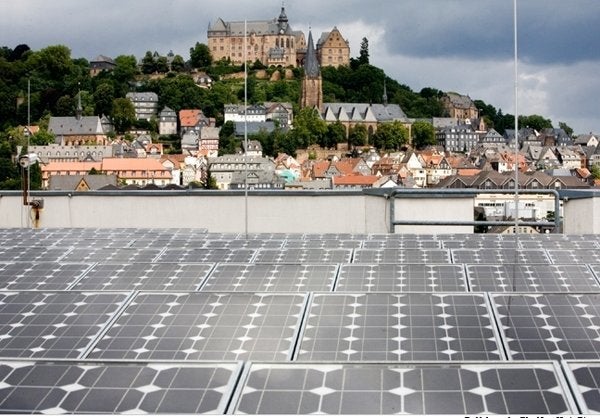
Many Americans have a hard time thinking about our energy future, largely because their energy present is so challenging. With gasoline prices hovering near $4 per gallon and rising energy bills at home and at work, our economy is struggling with the burden of imported oil and reliance on fossil fuels. The need to satisfy the nation's oil appetite has shaped our foreign and defense postures, and is a primary reason for our current entanglements overseas. Extreme weather here in the U.S. has us feeling uneasy. And the scientists remind us more urgently every week about the mounting manifestations of the climate crisis.
To solve these problems, we must repower our economy. Fast.
Vice President Gore has issued a challenge for us to do just that: Generate 100 percent of America's electricity from truly clean sources that do not contribute to global warming -- and do so within 10 years. It is an ambitious but attainable goal. American workers, businesses and families are up to it.
Meeting the challenge to repower America will deliver the affordability, stability and confidence our economy needs, as well as a healthy environment. And it will generate millions of good American jobs that can't be outsourced.
It will involve simultaneous work on three fronts. First, get the most out of the energy we currently produce. Second, quickly deploy the clean energy technologies that we already know can work. Third, create a new integrated electricity grid to deliver power from where it is generated to where people live.
The first front involves energy efficiency. The potential here is vast and largely untapped. Now is the time to begin a comprehensive national energy upgrade that will reduce the energy bills of homeowners and businesses -- even as costs of energy supplies may be on the rise.
The second front requires expanding the use of existing generation technologies. This will include accelerated growth in our wind energy industry. We have a strong running start -- the U.S. was the leading installer of wind technology last year. Texas oilman T. Boone Pickens says we can get at least 20 percent of America's electricity from wind power. We think he's right.
Solar thermal power is also booming and poised for rapid acceleration. The resource potential is so vast that a series of collectors in the American southwest totaling just 92 miles on a side could power our entire electricity system. Utilities in Arizona, Nevada, and California have already begun to tap this potential, with plans for powering nearly one million homes underway.
Advances in thermal storage technologies, along with investments in our grid, mean that solar thermal power will be able to provide electricity at night, like coal power does today.
Nuclear and hydroelectric power facilities currently combine to contribute roughly 25% of America's electricity. That will continue. Coal and natural gas can also play a significant role by capturing and storing their carbon emissions safely. Our hope is that this CCS emissions technology can be developed and commercialized quickly. Without it, coal isn't "clean." There are reportedly a few CCS plants now proposed in the U.S., although another roughly 70 proposed coal plants have no such plans to capture their carbon pollution.
The third front is the creation of a unified national electricity grid. A "super smart grid" will form the backbone and the entire skeleton of our modern power system. Efficient high voltage lines will move power from remote, resource-rich areas to places where power is consumed.
It will also allow households to make money by automatically using energy at the cheapest times and selling electricity back to the grid when a surplus is available can. A smart meter spins both ways.
Meeting this 100 percent clean power challenge will require a one-time capital investment in new infrastructure, with the bulk of funding coming from private finance. If policies reward reducing global warming pollution, private capital will flow towards clean energy solutions.
But the most important cost figures to consider may be the ones we'll avoid. American utilities will spend roughly $100 billion this year on coal and natural gas to fuel power plants. And more next year and the year after that -- until we make the switch to renewable fuels that are free and limitless.
The 10-year time frame is key.
The science, the economic pressures and our national security concerns demand swift, concerted action. The best climate scientists tell us we must make rapid progress to turn the corner on global carbon emissions or the ecological consequences will be irreversible.
The solutions are available now -- there are no technology or material impediments. Failing to move swiftly will deprive the U.S. economy of earnings from one of the fastest growing technology sectors in the world.
We've done this before. We mobilized the auto industry in 12 months to service the hardware needs of WWII. The Marshall Plan to reconstruct Europe was executed in four years. And as Vice President Gore pointed out, we reached the moon in eight years, not ten.
We can do this. With support from the American people and leadership from elected officials, America can accept the challenge of building a safe, secure and sustainable energy future.
Cathy Zoi is CEO of the Alliance for Climate Protection, whose "We" Campaign is working to enlist 10 million people to call for effective policies to help solve the climate crisis.